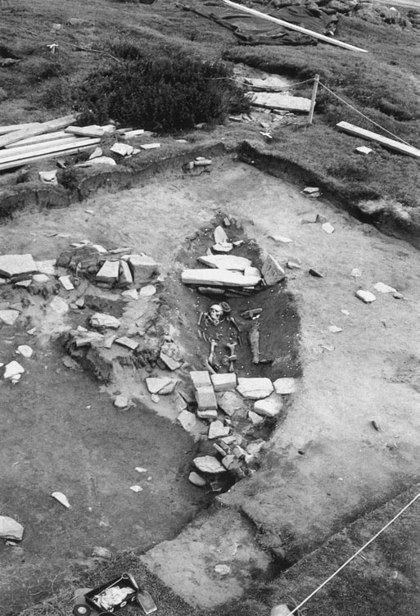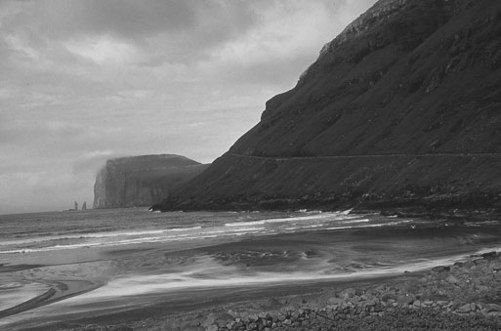The Vikings: A Very Short Introduction (14 page)
Read The Vikings: A Very Short Introduction Online
Authors: Julian D. Richards
Tags: #History, #General, #Social Science, #Archaeology, #Europe, #Medieval

melted down. The community cannot have been self-sufficient,
gs
however, and joints of beef and mutton were brought from farms in
and P
the bay, such as that at Buckquoy. Here successive generations of
ict
cellular buildings in distinctive Pictish figure-of-eight form were
s: genocide or a
replaced by rectangular halls, although Pictish artefacts continued in use, indicating some continuity in population. At Pool, on Sanday, there is a clearly identifiable period of overlap between the
ssimilation?
12. Brough of Birsay: aerial view
91
two cultural groups. Pictish buildings were adopted and reused by inhabitants who had access to Norse material, particularly soapstone.
Altogether
c
.130 Scandinavian-style burials have been recognized on Orkney, a number consistent with significant population migration, and reflecting a more broadly-based settlement than in the Hebrides. All can be placed within 850–950, although most were discovered in the 19th century and records are poor.
The cemetery at Westness on Rousay has been excavated relatively recently. It consisted of 32 inhumations, but only eight graves – four male and four female – were accompanied. One grave was of a mother in her twenties, buried with her baby. She had been dressed wearing a pair of oval Norse brooches and a string of beads, but also wore a remarkable silver and gold penannular Celtic brooch. This
s
wealthy woman may have been the head of the founding family. Two
g
kin
male warriors were each buried in small rowing boats. At least one
e Vi
had died in battle as the broken tips of four arrows were lodged in
Th
his back. The rest were buried without grave-goods in stone-lined cists, and these probably represent the graves of the pre-Norse population. Their position was marked on the surface by boulders, and none had been disturbed by the Norse. On the same promontory there was a boat house and a farmstead comprising a large hall furnished with low wall benches either side of the hearth, and two byres: one for cattle, and one for sheep.
Another boat burial was found in 1991, eroding out of a low cliff at Scar, on Sanday. The boat was a small rowing vessel which – from the presence of igneous rock particles in the caulking – must have been built in Norway, and brought to Orkney by a larger vessel. A woman in her seventies had been given pride of place in the centre.
Her grave-goods included a maplewood box, an iron cooking spit or weaving batten, and a fine whalebone plaque, of north Norwegian type. She was also accompanied by a child, aged about 10, and a male in his thirties who had been squashed into one end of the boat; 92

13. Westness, Rousay. Male boat grave with the prow and stern packed
with stones to create a central chamber for the body
indeed his foot may have been broken in order to force him into the space. Nonetheless, he was no slave for he carried a comb, a sword, and a quiver of arrows, as well as 22 whalebone gaming pieces.
Although the objects would place the burial in the late 9th century, radiocarbon dating suggests a date closer to the mid-10th century, indicating that many of the objects were heirlooms and that this was a group maintaining an old cultural and religious identity in the face of growing Christianization of the Norse colonists.
At St Magnus on Birsay, and at Deerness, there were private stone chapels as early as the 10th century, and by the 11th century considerable resources were invested in church building throughout Orkney. At Newark Bay a rectangular stone building underlay the later church. It was surrounded by
c
.250 burials which respected it apart from two burials inserted into the floor. Two 10th-century coins were found beneath the stone floor and
s
20 radiocarbon dates from the burials are consistent with
g
kin
mid-10th-century usage of the cemetery. It has been suggested that
e Vi
the occurrence of
Papa
place names on Orkney reflects the survival
Th
of Pictish Christian enclaves that were responsible for the early conversion of the Norse. It seems clear, however, that by 900 the Picts had been eclipsed – politically, linguistically, culturally, and socially. Their aristocracy had been displaced by Norse war leaders and only at the lower levels of society can survival of a native element in the population be perceived.
Shetland
Shetland appears fleetingly in the
Orkneyinga Saga
, but it is generally assumed that it was colonized at the same time as Orkney, and enjoyed close connections with Norway. Hitherto there has been little archaeological investigation of Norse sites, and our knowledge has relied upon Jarlshof where, in 1934, Alexander Curle excavated the first Norse farmstead to be identified in the British Isles. Although it was described as a township, Jarlshof was never more than a farmstead, rebuilt many times, with the Norse 94
longhouses erected adjacent to a Pictish broch. At Old Scatness Norse artefacts have also been found within an abandoned broch, suggesting that here and at Jarlshof they may have been targeting Pictish estate centres. The Norse finds coincide with economic changes, including the introduction of flax cultivation (possibly for linen for use in fishing nets) and more intensive exploitation of marine resources, although barley and oats were still grown.
Fieldwork by Stefan Stumann Hansen on the small island of Unst has sought to map fragments of a Norse landscape. The island is now largely depopulated, with a present population of
c
.600
inhabitants. However, the remains of Norse buildings have been recorded at 30 locations, and several have been excavated, including
Vikin
Hamar, Sandwick, and Soterberg. These sites are difficult to date.
gs
There is a small number of accompanied burials on Unst, such as
an
d P
Clibberswick, with 9th-century finds. The settlements may start in
ict
that period, but many are long-lived and continue in use until the
s: genocide or a
14th and 15th centuries.
Most comprise typical Norse longhouses with wall benches and
s
central hearths; soapstone vessels, spindle whorls, and net sinkers
similation?
are common finds. As Shetland was already treeless, the timbers for the main structural beams must have been imported. At Underhoull a bow-sided hall was constructed with footings from stone recycled from an Iron Age broch and other Pictish structures.
A paved floor and drain at one end suggested it had been used as a cattle byre. The extravagant use of timber for the construction of Scandinavian-style longhouses can hardly be regarded as particularly functional. Pictish architecture tended to make use of stone rather than timber. The longhouse must have been regarded as a statement of cultural identity of almost symbolic importance to the settlers, allowing them to ‘feel at home’ and to express a sense of community in opposition to other native communities and identities.
Associated economic changes support the idea of a Norse takeover 95
in Orkney and Shetland. James Barrett has shown that whereas in the pre-Norse period fishing was largely a littoral activity, there was now large-scale exploitation, and an increased dietary importance of marine protein. Such fundamental changes in subsistence activity are more likely to result from large-scale colonization than from the influence of a small immigrant elite. This is particularly likely in the case of fish consumption, which was probably relatively low-status. Unlike changes in language or costume there would have been little motivation for the local population to adopt new economic practices unless this was necessitated by demographic change. This intensification of fishing must therefore have been related to the distinct cultural practices of a large immigrant population, and if not genocide, must still imply considerable population replacement.
Nonetheless, although Norse cultural traditions have retained a
s
political importance in both the Northern and Western Isles, it
g
kin
would be a mistake to see them as a straight Scandinavian import.
e Vi
The incoming populations already demonstrate cultural mixing,
Th
and elements of indigenous culture were also retained and adapted, at least in the lower social strata. To examine the colonization of virgin territories without indigenous inhabitants we must travel further across the North Atlantic.
96
Viking colonization had a crucial role in shaping national identities across the North Atlantic, and Scandinavia is seen very much as the ancestral homeland. This chapter will range from the Faroes to Iceland, and from 800 to 1400, as it examines how far Viking identity and culture survived from Scandinavia and how far it was reinvented in 13th- and 14th-century sagas.
Colonization of the Faroes
The Faroes, literally ‘Sheep islands’, are a group of 18 islands, 290 kilometres north-west of Shetland, and 675 kilometres from the west coast of Norway. Today they have a population of
c
.45,000
which proudly preserves its Norse heritage, including the infamous whale drives. The Faroese have their own Scandinavian language, halfway between Norwegian and Icelandic. During the 19th century they began to explore their roots, looking variously to Irish hermits, Norse exiles, and Basque whalers. The leading Faroese Home Rule politician, Jóannes Patursson (1866–1946) promoted the development of Faroese archaeology, but it was Sverri Dahl (1910–87), curator of the national museum (founded 1952), who excavated the first artefact that could be attributed to the Vikings: a ringed pin from a beach-side grave at Tjørnuvik.
97
In 825 an Irish source, Dicuil, writing in Charlemagne’s court in Aachen, finished his compilation of the most advanced geography of the time,
De Mensura Orbis Terrae
. Dicuil referred to small islands to be reached by two days’ sailing north of Britain; some of these islands had been uninhabited until settled by Irish hermits.
After 100 years of occupation the hermits had been driven away by pirates, although the islands were still filled with countless sheep and diverse sea birds. Although Dicuil fails to name the islands it is generally accepted that he was referring to the Faroes. The accepted wisdom, therefore, was that the Norse settlement, or
landnám
, literally land-taking, took place in the 9th century, with the small Gaelic strain in Faroese language and place names surviving from the Irish hermits.
According to the
Færeyinga Saga
(
c
.1200) the main colonization took place in the 870s when Grimur Kamban sought refuge from
s
Haraldr Finehair of Norway. However, there is no archaeological
g
kin
evidence for Irish anchorites, and it has also been observed that the
e Vi
Gaelic element in Faroese culture cannot be a result of 8th-century
Th
hermits who should not have been in a position to have children!
Another explanation for the Gaelic strain is that the original Viking settlers were first- or second-generation Norse from the Northern Isles or Ireland. At one stage pollen evidence was thought to reflect human activity
c
.650 but that has now been discredited, and the earliest dates are now
c
.875–900.
There has been little excavation on the Faroes. A Norse hall and byre were excavated at Kvívík in 1941. There was evidence for cereal cultivation and room for up to 12 cattle in the byre, but sea birds and whales were also exploited. In the 1980s, a small 10th-century settlement was excavated at Toftanes. Despite the scarcity of timber the longhouse was of typical Norse stave construction. The majority of the finds were imported, including over 700 soapstone objects, hones, quern stones, a wooden gaming board, two ringed pins, and a jet bracelet, possibly from Dublin.
98
